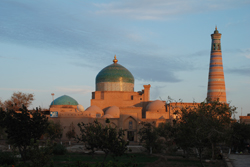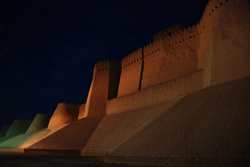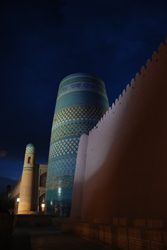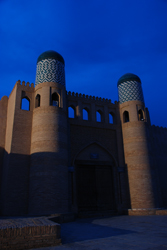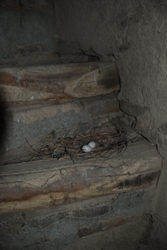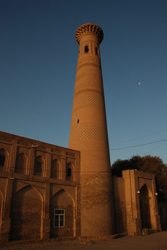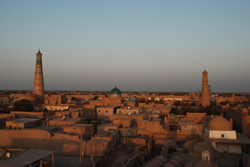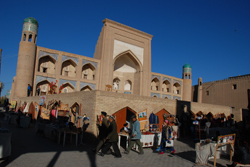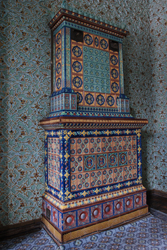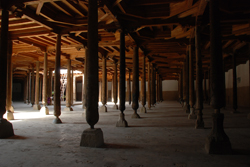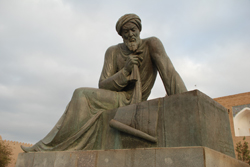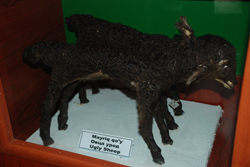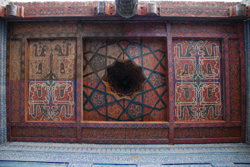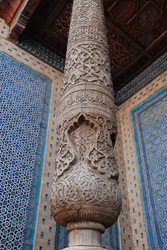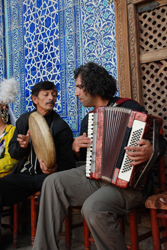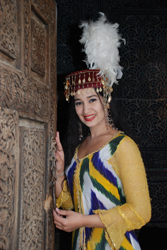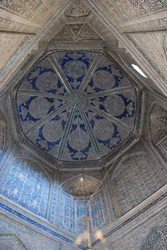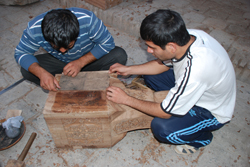Khiva: From Desert Empire to Tourist Trap
18 October, 2008, 04:53 am in "Uzbekistan"
When the sun sets you can finally breathe freely in Khiva. Then time slows and you can notice the graceful lines of the minarets and walls without the distraction of streets filled with souvenir stalls, blasting music from bootleg CD/DVD sellers and crowds of tourists. Bats flutter above the brick walls, shadows against the sky.
Around 7:30 AM, you can also walk the streets of Khiva and maintain a peaceful state of mind. At this hour, the sun has just risen and begun to paint the minarets and tops of the buildings with golden light. As we walked through streets, refreshingly empty save a few locals passing though on their way to work, we finally were able to get a sense of the true beauty of the architecture. We left the inner city through the East gate and climbed the tight winding staircase of the Said Niyoz Sholikorboy minaret, located in an 1842 mosque just outside the gate. Last night Rowshan had talked to the mosque caretaker, a kind older man who wore a traditional big woolly hat. He let us climb up and when Rowshan asked, he said we could climb it in the morning as well. The stairs apparently weren't climbed often since a dove had built her nest on one of the steps. It contained 2 white eggs. A couple steps below had a dead chick. The bird fluttered off as we climbed up. This morning she fluttered off again as we climbed. I hope she came back after we left.
From the top of the minaret, we watched the outer city coming to life while the inner city still slept. The bazaar below us began to be occupied by vendors putting out their goods. Noises of vehicles, people and carts rose from the streets below. Even though the inner city is a museum, from above one can see numerous satellite dishes and wires.
Back in the inner city we walked by the buildings admiring the structures instead of avoiding the souvenir sellers. Khiva is a beautiful place, however, we are looking forward to leaving. We've spent the past 2 days walking through pristine brick, car-free streets by carefully restored buildings. In many of the buildings are museums, however there is also at least 1 but more likely a whole army of souvenir sellers. You try to admire a wall of tile-work or an ancient artifact and someone shoves knitted socks or postcards at you. This doesn't happen occasionally but in most places you visit. Outside, you run the gauntlet of table after table. Fortunately, they take more interest in tour groups than independent travelers.
Of course maybe in old Khiva the streets were also filled with vendors but at least then it would have represented “real life”. I think the locals avoid the center unless they work there. All the businesses are geared towards tourists (and priced accordingly). Even the businesses right outside the walls have a tendency to be over priced.
We finally found a reasonably priced restaurant last night. They don't serve dinner but were able to set us up with a meal of manti and yogurt for a price closer to what it should be for a meal, less than 2000 som. The main dishes in the inner city are at least twice the price with smaller servings and worse food.
We had just been up in the minaret so were a bit dusty. At the restaurant, Rowshan asked if there was a toilet. One of the women there responded, “You can speak Uzbek?”. Rowshan responded he was Azeri from Iran. “Are you a Moslem?” was the next question. “Yes,” Rowshan replied, wishing she would just point out the toilet. Then she said something that Rowshan swore was, “Are you circumsized?” and judging from the laughter that followed, probably was. Rowshan responded, “Yes,” and the woman pointed out the toilet's location. We couldn't help wondering what would have happened if he said, “No.” Would they have not allowed him to use the toilet? I joked that maybe they would have spied on him in order to see it if he had said he wasn't. The manti and yogurt hit the spot. And so we went to lunch and had laghman there today.
Annoying souvenir vendors aside, Khiva is worth seeing. We started our sightseeing in the one site outside of the city walls covered by the ticket, the 1912 palace of Nurullabay (also called Isfandyer Palace). The exterior was plain bricks and wood columns but the inside made up for any lack of exterior decoration.
The first room's walls were covered from floor to ceiling with sea-foam green and gold filigree. The ceiling was an odd mix of Islamic designs and Art Nouveau flourishes. Each room had ceramic tile covered stoves also completely covered with decoration.
We finally found a reasonably priced restaurant last night. They don't serve dinner but were able to set us up with a meal of manti and yogurt for a price closer to what it should be for a meal, less than 2000 som. The main dishes in the inner city are at least twice the price with smaller servings and worse food.
We had just been up in the minaret so were a bit dusty. At the restaurant, Rowshan asked if there was a toilet. One of the women there responded, “You can speak Uzbek?”. Rowshan responded he was Azeri from Iran. “Are you a Moslem?” was the next question. “Yes,” Rowshan replied, wishing she would just point out the toilet. Then she said something that Rowshan swore was, “Are you circumsized?” and judging from the laughter that followed, probably was. Rowshan responded, “Yes,” and the woman pointed out the toilet's location. We couldn't help wondering what would have happened if he said, “No.” Would they have not allowed him to use the toilet? I joked that maybe they would have spied on him in order to see it if he had said he wasn't. The manti and yogurt hit the spot. And so we went to lunch and had laghman there today.
Annoying souvenir vendors aside, Khiva is worth seeing. We started our sightseeing in the one site outside of the city walls covered by the ticket, the 1912 palace of Nurullabay (also called Isfandyer Palace). The exterior was plain bricks and wood columns but the inside made up for any lack of exterior decoration.
The first room's walls were covered from floor to ceiling with sea-foam green and gold filigree. The ceiling was an odd mix of Islamic designs and Art Nouveau flourishes. Each room had ceramic tile covered stoves also completely covered with decoration.
The 2nd room was octagonal with windows and mirrors. The ceiling was painted with traditional Uzbek designs but the walls were filled with gaudy filigree even more detailed than the previous room. A giant chandelier with gold roses hung form the center. By this room I was beginning to feel a bit frenzied from all the clashing patterns. Unlike the detail oriented Persian designs which always give the eye some place to rest, there was no break until the 4th room. This room had Art Nouveau wall paintings which had some spaces. The last room had some tacky ceiling paintings with cherubs. I couldn't wait to get back outside away form the overdone decor. Next to the palace was a closed walled area with a pretty gate decorated with emerald and indigo tile patterns.
Inside the Old Town gates, we visited the Juma Mosque, a huge rectangular room with a wood ceiling supported by 213 carved wooden columns. There were 2 skylights which provided light. The ceiling was often just wooden cross beams but in an area in the front were several sections built with the stack of 4 squares used in Pamir houses.
Inside the Old Town gates, we visited the Juma Mosque, a huge rectangular room with a wood ceiling supported by 213 carved wooden columns. There were 2 skylights which provided light. The ceiling was often just wooden cross beams but in an area in the front were several sections built with the stack of 4 squares used in Pamir houses.
We visited a lot of places. Many had ornate tile-work and/or painted ceilings. The museums were small affairs with some samples on a theme. Some were more interesting than other. A lot of the time we just went to the museum exhibits because they were in the buildings. However, sometimes we got a surprise of something really unique. The Matpaner Bay Medressa had an exhibit about Al-Kharazmi, a famous mathmetician (the word “algorithm” comes from his name). The nature museum had a sheep with one head and 2 bodies captioned, “Ugly sheep”.
Probably the most ornate buildings were the Tosh Hovli Palace, the Pahlavon Mahmud Mausoleum and areas of the Khuna Ark. We ended up spending quite a while at the Tosh-Hovli palace though not because we were admiring the decoration but because Rowshan started playing music with a musician family that worked there.
He played some drums and then accordion and I danced with some of the women. Some of the vendors joined in as well and it was quite fun. We chatted and were offered some tea. Rowshan asked me if I thought we should leave some money for the tea. I said I didn't think so because unlike in places like the Pamirs where people were terribly poor, here people were working in an area of tons of tourists. As it was, we didn't need to even have had the conversation because the woman we thought had offered us tea to be friendly, charged us 3000 for it! (usually tea is around 200!) Disappointed that the people we thought were just enjoying our company and being friendly were just trying to rip us off like any other rip-off artist in town, even after Rowshan had entertained them with quite a few songs, we decided tourism is making Uzbeks loose the hospitality they maintain in other places like Kyrgyzstan.
We had originally planned to spend four or five days here in Khiva but now we are hoping to leave tomorrow. Khiva has really made me wonder about the value of tourism. On one hand it can provide a lot of people with income. But on the other hand, the businesses that used to operate for locals have been chased out of the center as well as normal city life. Everything is meant for tour groups. It is hard to meet and talk to people. They all seem to want something from you. Even in the bazaar they gouge prices for tourists. You don't have much of a choice. Khiva seems like a place that could offer a lot and occupy a lot of time spent wandering but it just gets tiring to be constantly bombarded with it. There are several chaihanes in the inner city and just outside but they seem to have completely switched to tourist clients. Some places don't even serve food unless a tour group has ordered meals in advance. It feels like tourism has stolen these places from the locals. Locals can't afford the prices, so when there are no tourists, they just seem to close down.
I do have to admit I liked the Pahlavon Mahmud Mausoleum. There were 2 tombs in different rooms with beautiful tile lined walls and domes, arching above like the branches of trees in a jungle. This is the burial place of a wrestler who is kind of the patron saint of Khiva. Many people come to pray there.
I do have to admit I liked the Pahlavon Mahmud Mausoleum. There were 2 tombs in different rooms with beautiful tile lined walls and domes, arching above like the branches of trees in a jungle. This is the burial place of a wrestler who is kind of the patron saint of Khiva. Many people come to pray there.
One positive thing about Khiva is they encourage handicrafts. There are a lot of wood carvers working on ornate columns (it takes 4 months to complete 5) or smaller pieces. There is also a wood carving school headed by Shavkat Jumaniazov. Today we visited a weavi
ng/miniature workshop. Though it also looked shut down except when tourists groups came by, I did manage to talk a bit with a miniature artist. He had been trained in Tashkent and specialized in tezhip designs which he painted with tempera and watercolor. He made the paper mache lacquer boxes at home and painted during the day in his workshop.
ng/miniature workshop. Though it also looked shut down except when tourists groups came by, I did manage to talk a bit with a miniature artist. He had been trained in Tashkent and specialized in tezhip designs which he painted with tempera and watercolor. He made the paper mache lacquer boxes at home and painted during the day in his workshop.
We had a bit of a scare up in the Islom Hoja minaret. We were at the top. Rowshan was taking photos and stepped backwards into the gap where the stairs came up. He tumbled backwards about 4-5 feet down onto the stone stairs. Fortunately, for Rowshan, a man was walking up the stairs so he landed partly on his shoulder, supporting the rest of his weight grabbing the ledge. The man and his friends were from Tashkent. His shoulder seemed a little sore but he insisted he was fine. We joked that Rowshan was saved by the Tash-Adam (Stone Man) from Tashkent (Stone city).
Comments
- Comments
Powered by My Blog 1.69. Copyright 2003-2006 FuzzyMonkey.net.
Created by the scripting wizards at FuzzyMonkey.net..
(Code modified by Rowshan Dowlatabadi)
Created by the scripting wizards at FuzzyMonkey.net..
(Code modified by Rowshan Dowlatabadi)


